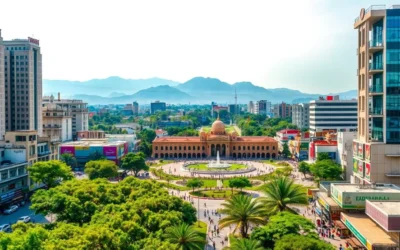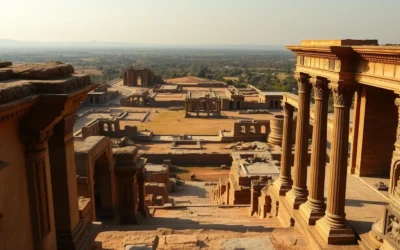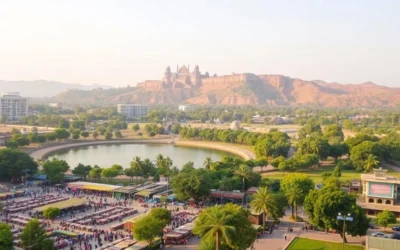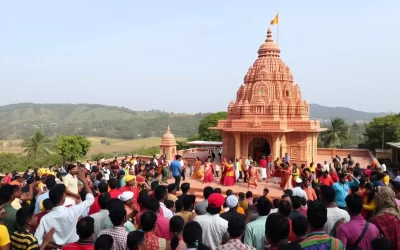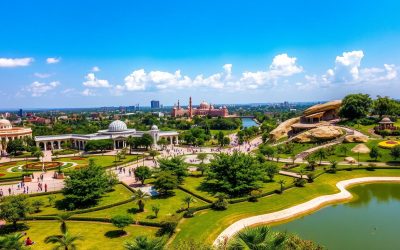✓ Accommodations✓ Flights✓ Rental Cars
Are you ready to explore the vibrant state of Haryana in northern India? Understanding the best time to visit can make all the difference in your travel experience.
The state’s diverse climate means that the ideal time for a trip depends on your preferences for weather, activities, and festivals. Generally, the period between October and March is considered optimal due to the warm, sunny, and dry conditions.
However, each season has its unique charm and drawbacks. This guide will walk you through the pros and cons of visiting during different times of the year, helping you plan a weather-savvy trip tailored to your needs.
Understanding Haryana’s Climate: A Year-Round Overview
The state’s geography plays a crucial role in shaping its climate over different months. Haryana, located in the northern part of India, experiences a varied climate due to its proximity to the Himalayas and the Thar Desert.
Geographic Location and Climate Influences
Haryana’s climate is influenced by its geographic location. The state’s terrain varies from the Shivalik hills in the north to the flat plains in the south. This variation in terrain contributes to the diverse climatic conditions experienced across different parts of Haryana during the year.
December to March is typically the dry season, with vast swathes of the country being warm and sunny. However, the far north experiences chilly temperatures and snow at higher altitudes during these months.
Haryana’s Four Distinct Seasons
You will experience four well-defined seasons when visiting Haryana. The monsoon season, which lasts from July to September, brings significant rainfall and relief from the summer heat.
- Winter (October to February) brings cool temperatures with foggy mornings and chilly evenings.
- Summer (March to June) is characterized by rising temperatures, often exceeding 40°C (104°F) in May and June.
- The monsoon season provides relief from the summer heat but brings humidity and occasional heavy downpours.
- The post-monsoon period (late September to early October) offers pleasant weather with moderate temperatures and reduced humidity.
Each time of the year presents a different face of Haryana, influencing agricultural activities, cultural celebrations, and tourist experiences. Understanding these seasonal changes is crucial for planning your visit at the right time.
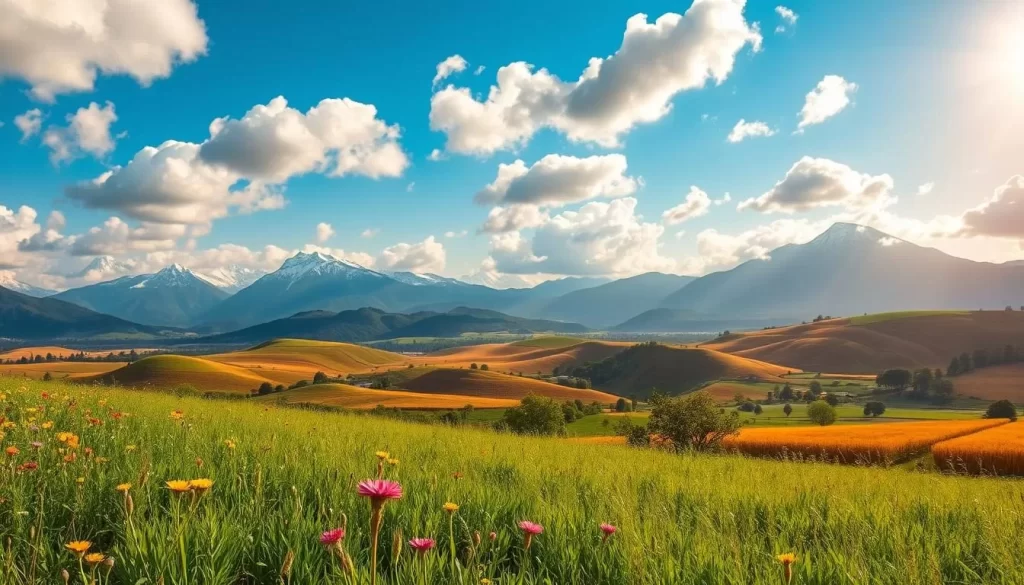
Winter in Haryana (October to February)
The winter season in Haryana, between October and February, is marked by comfortable temperatures, making it the best time for tourists to enjoy the state’s offerings. This period is ideal for exploring Haryana’s rich cultural heritage and natural beauty.

Temperature Ranges and Weather Patterns
During winter, Haryana experiences a pleasant climate, with clear blue skies and cool temperatures. December and January are the coolest months, with potential fog in the mornings, while the higher Himalayan regions can be quite cold. However, the clear mountain views during this time are a treat for visitors.
Winter Festivals and Cultural Experiences
Winter is a great time to experience Haryana’s vibrant culture through its various festivals and events. You can immerse yourself in local traditions, enjoy traditional cuisine, and participate in festivities that showcase the state’s rich heritage.
Pros and Cons of Winter Travel
Traveling to Haryana during winter has its advantages and disadvantages. On the positive side, the comfortable temperature range makes it ideal for sightseeing, and the clear visibility offers great photo opportunities. However, popular destinations can get crowded during peak winter months, and prices for accommodations tend to be higher. Additionally, morning fog might occasionally disrupt early morning plans.
Some benefits of visiting Haryana in winter include:
- Comfortable temperatures for outdoor activities
- Clear visibility and photogenic landscapes
- Reliable road conditions and transportation services
On the downside, you might encounter:
- Crowds at popular tourist spots
- Higher prices for accommodations
- Occasional morning fog disrupting plans
Summer in Haryana (March to June)
With the arrival of summer, Haryana witnesses a considerable rise in temperature, making it a challenging time to explore. The period from March to June is characterized by increasing heat, with April and May offering excellent value trips despite the high humidity and occasional thunderstorms.
Heat Waves and Temperature Considerations
Summer in Haryana is marked by intense heat waves, with temperatures soaring during the day. The mid-summer months of May and June are particularly hot, making it essential to plan your activities around the cooler parts of the day. Visiting outdoor attractions early in the morning or later in the evening can help you avoid the peak heat.
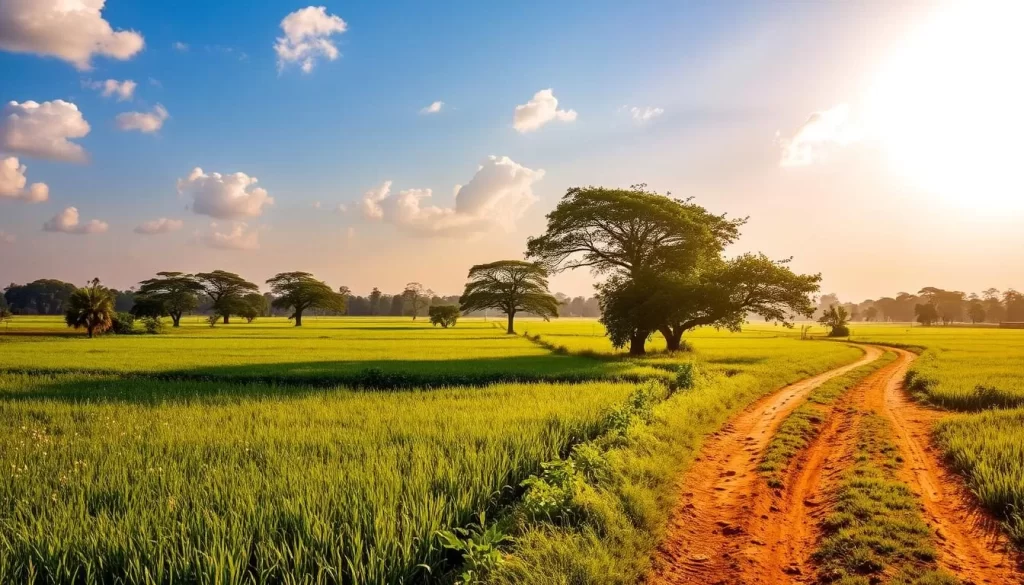
Summer Activities and Attractions
Despite the heat, Haryana offers several attractions and activities during the summer. You can explore indoor attractions like museums and shopping malls, which provide a cool respite from the heat. Additionally, many tourist spots offer evening events and light shows, making them ideal for summer visits.
| Attraction | Type | Best Time to Visit |
|---|---|---|
| Museum | Indoor | Anytime |
| Historical Monuments | Outdoor | Early Morning or Evening |
| Shopping Malls | Indoor | Anytime |
Tips for Handling the Summer Heat
To make the most of your travel guide to Haryana during the summer, it’s crucial to stay hydrated by consuming plenty of water and electrolyte solutions. Dressing in loose, light-colored cotton clothing and using sun protection like hats, sunglasses, and sunscreen can also help. Choosing accommodations with reliable air conditioning and planning for regular rest periods can make your trip more comfortable.
By following these tips and being mindful of the heat, you can enjoy your travel experience in Haryana even during the hot summer months.
Monsoon Season (July to September)
The monsoon season brings a dramatic change to Haryana’s landscape, turning it into a vibrant green haven. This period, spanning from July to September, is characterized by significant rainfall that rejuvenates the state’s agricultural heartland.
Rainfall Patterns and Humidity Levels
During the monsoon season, Haryana experiences a substantial increase in rainfall, with August being the wettest month. The humidity levels also rise significantly, creating a humid and warm climate. The average rainfall is a welcome change for the agricultural sector, as it helps in the cultivation of crops like rice and millet.
Monsoon Travel Challenges and Opportunities
While the monsoon season can pose some challenges for travelers, such as potential flooding and increased humidity, it also offers unique opportunities. You can enjoy fewer tourists and lower accommodation rates, making it a budget-friendly time to visit. Additionally, the landscape becomes incredibly lush and picturesque, ideal for nature lovers and photographers.
Lush Landscapes and Agricultural Beauty
The monsoon transforms Haryana’s typically dry landscape into a verdant panorama. You’ll witness the agricultural heartland come alive as farmers plant monsoon crops across the countryside. The numerous lakes and water bodies fill to capacity, creating picturesque views and attracting various bird species. Rural Haryana is particularly beautiful during this season, with emerald fields stretching to the horizon under dramatic cloud formations.
- The monsoon brings life to Haryana’s agricultural fields, making it a great time to see the countryside.
- You can enjoy the natural beauty of the state, with lush greenery and vibrant colors.
- The numerous water bodies fill up, creating beautiful views and attracting bird species.
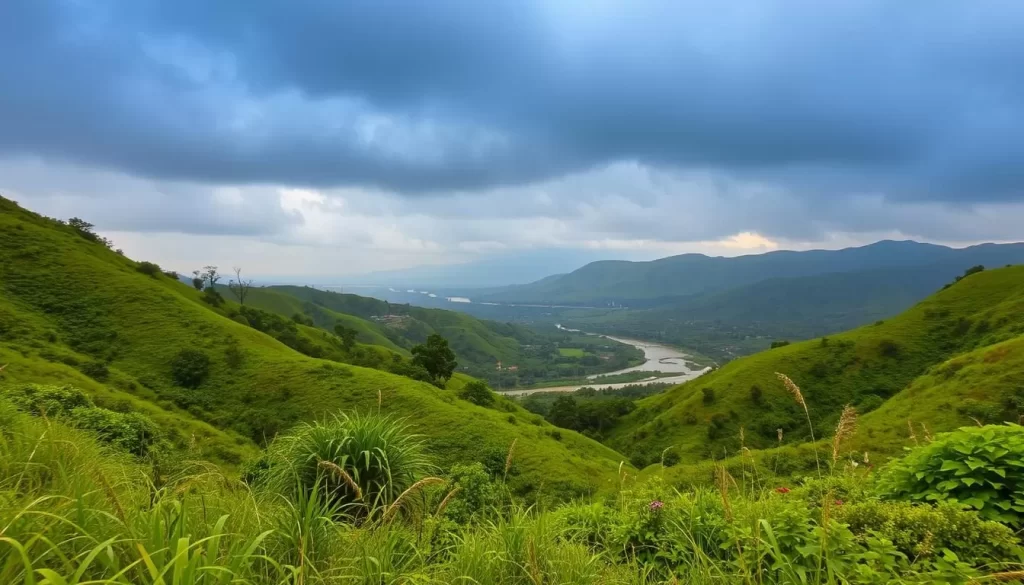
Haryana, India: Best Months for a Weather-Savvy Trip
To make the most of your trip to Haryana, it’s crucial to know the best time to visit based on weather conditions. The state’s climate varies significantly throughout the year, making some months more suitable for a visit than others. Generally, the period between October and March is considered ideal due to warm, sunny, and dry weather.
October to November: The Golden Period
October and November are considered the golden period for visiting Haryana. The weather is pleasant, with clear blue skies, making it perfect for exploring the region, including the Golden Triangle tourist circuit. The comfortable temperatures allow for a enjoyable experience of Haryana’s cultural and natural attractions.
February to March: Spring Delights
February and March bring the charm of spring to Haryana. The weather is mild and pleasant, with the landscape adorned by blooming flowers and lush greenery. It’s an excellent time year for outdoor activities and sightseeing, as the temperatures are neither too hot nor too cold.
December to January: Winter Charm with Considerations
December and January offer a distinctly different experience in Haryana, with cooler temperatures and a winter charm. While mornings and evenings can be chilly, the days remain pleasant. Travelers should be prepared for potential morning fog, particularly in December. However, this period is ideal for those who prefer cooler weather and wish to experience Haryana’s winter character, including unique cultural experiences like harvest festivals.
Planning Your Visit: Essential Weather Considerations
As you plan your trip to Haryana, understanding the weather considerations can greatly enhance your travel experience. The state’s climate varies significantly throughout the year, impacting your travel plans, packing, and overall enjoyment.
Packing Tips for Different Seasons
Packing appropriately is crucial for a comfortable trip. During the summer months, light, breathable clothing is a must, while warm layers are necessary for the chilly winter mornings and nights. Monsoon season requires waterproof gear and quick-drying clothes.
Transportation and Weather Impacts
Weather can significantly affect transportation in Haryana. Heavy rain can lead to road delays, while extreme heat may impact travel comfort. Planning your transportation in advance, considering the weather forecast, can help minimize disruptions.
| Season | Transportation Tips |
|---|---|
| Summer | Opt for early morning or late evening travels to avoid heat. |
| Monsoon | Be prepared for potential roadblocks and flooding. |
| Winter | Enjoy smoother travels, but check for fog-related delays. |
Accommodation Choices Based on Weather
Choosing the right accommodation can greatly enhance your experience. Hill retreats offer a cooler respite during the summer, while hotels with reliable heating are a must for winter comfort. During the monsoon, accommodations with covered walkways and indoor activities can be particularly appealing.
Conclusion: Making the Most of Your Haryana Trip Whatever the Weather
With its relatively moderate climate, Haryana is a versatile destination that can be enjoyed during any time of the year, provided you’re well-prepared. The best time to visit Haryana is between October and March when the weather is warm, sunny, and dry, making it ideal for exploring its cultural and historical sites.
However, each season in Haryana offers unique experiences. For instance, the winter months (December to February) are perfect for those who enjoy cooler weather and cultural festivals, while the monsoon season brings lush landscapes and agricultural beauty. By aligning your travel plans with your specific interests, you can make the most of your trip.
Consider combining your visit to Haryana with trips to neighboring states, taking advantage of the seasonal variations. Flexibility in your itinerary allows you to adapt to changing weather conditions. Local seasonal specialties in cuisine, festivals, and cultural activities add unique dimensions to your experience. By understanding Haryana’s seasonal rhythms and planning accordingly, you’ll be well-equipped to enjoy this culturally rich north Indian state regardless of when you choose to visit.
The above is subject to change.
Check back often to TRAVEL.COM for the latest travel tips and deals.

